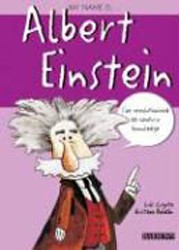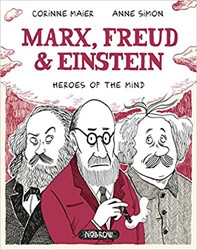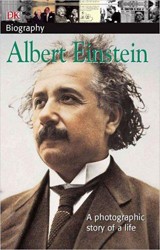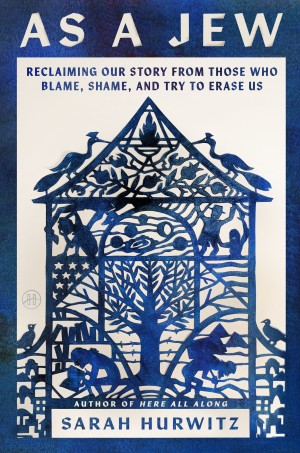This graphic biography, illustrated in shades of black, white, and gray, introduces readers to the life of Albert Einstein and the times in which he lived. Einstein, one of the foremost thinkers of the twentieth century, had a powerful impact on the world as we know it today.
The story is primarily narrated by Einstein and floats back and forth in time as he recollects events while he attempts to put them into historical and personal context. It begins with Albert’s childhood and the concerns of his parents and teachers as to what a dreamy child like him could possibly be capable of accomplishing throughout a lifetime. The gift of a compass, given to Albert by his father, is a turning point which opens his eyes to new possibilities and areas to explore. His early career with its personal and political complications due to World War II, and the challenges faced by world leaders at that time, lead both directly and indirectly to his groundbreaking scientific success and to the impact of his discoveries on world events.
The authors do not shy away from discussion of his Jewish identity and the effect that may have had on his scientific career, as well as how it affected world history.
The book extensively explores Einstein’s life and theories, although it may be a bit too ambitious with densely packed information in almost every panel. It is quite a lot for a young reader to absorb at once. Nevertheless, this thought-provoking, comprehensive biographical portrait can be a vehicle for sparking curiosity about the way the world works and will inspire some readers to take an active interest in scientific inquiry. The detailed illustrations are filled with both motion and emotion; the text and art are well blended, allowing the reader to come away with a clear picture of Einstein’s life.
Reader education continues with the included back-matter. There is a list of key dates in Einstein’s life accompanied by a timeline, as well as a bibliography. There is a source list which includes not only traditional books and periodicals, but also a film, a TV series, and radio and video documentaries. Notable is a section focusing on ideas for readers to reflect upon, consisting of many of Einstein’s fascinating and incisive quotes. These quotes are well-chosen and deliver their messages in substantive, pithy phrasing. They are a perfect blend of poetry and science and make a great impact on a reader who has just finished reading Einstein’s life story. The appended material is illustrated in the same style the graphic artist employed throughout the book.
Michal Hoschander Malen is the editor of Jewish Book Council’s young adult and children’s book reviews. A former librarian, she has lectured on topics relating to literacy, run book clubs, and loves to read aloud to her grandchildren.





